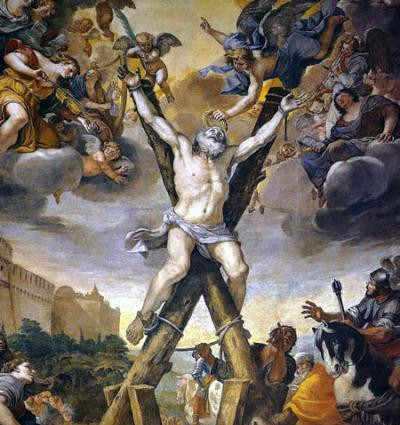
Saint of the Day November 30: St. Andrew
St. Andrew the Apostle: Life, Legacy and Significance in the Christian Faith
Name
St. Andrew
Title
Apostle
Birth
06 B.C., Bethsaida
Death
November 30, 60, Petrasus
Recurrence
30 November
Prayer
For that admirable readiness with which you, O glorious St. Andrew, gave yourself to follow Jesus Christ and to Him led your brother, who later became the head of the Apostolic college and the foundation stone of the church; deh! obtain for us all the grace to follow promptly the divine inspirations, to confess generously the truth, to love always the crosses and sufferings of this earth, in order to secure for ourselves the perfect and eternal goods of Paradise.
Patron Saint of
Empoli, Pioltello, Portogruaro, Sarzana, Castel Maggiore, Riva del Garda, Sommacampagna, Vinci, Carugate, Montespertoli
Protector of
Singers, sailors, fishermen
Roman Martyrology
Feast of Saint Andrew, Apostle: born in Bethsaida, brother of Simon Peter and a fisherman with him, he was the first among John the Baptist’s disciples to be called by the Lord Jesus at the Jordan, followed him and led his brother to him as well. After Pentecost he is said to have preached the Gospel in the region of Achaia in Greece and suffered crucifixion in Patras. The Church of Constantinople venerates him as its distinguished patron.
The Saint and Mission
St. Andrew, one of the original apostles of Jesus Christ, holds a special place in the history of the Church because of his role in the Christian mission. His figure symbolizes the essence of the apostolate, which is the spread of Jesus’ message and the fulfillment of the divine mission on earth.
St. Andrew’s call by Jesus at the Sea of Galilee represents a decisive moment: he leaves his fisherman’s net to become a “fisher of men,” thus symbolizing the transformation from an ordinary life to a life dedicated to God’s mission. This passage marks the beginning of a journey marked by unconditional dedication to spreading the Gospel.
St. Andrew distinguished himself by his missionary zeal, traveling to different regions to proclaim the Gospel. His mission was not only to proclaim the Good News, but also to live according to Christ’s teachings, demonstrating by his life the truth and love he preached. This aspect of his mission is particularly relevant: the consistency between word and deed, between preaching and lifestyle.
His end, martyrdom on an X-shaped cross, is a powerful example of his faithfulness to this mission. In his sacrifice, St. Andrew embodies the essence of the Christian message: faithfulness to God to the end, even in the face of great suffering. His life and martyrdom are an invitation for Christians in every age to live their mission with courage and dedication, following the example of Christ and his apostles.
St. Andrew is not only a historical figure of Christian antiquity, but an ever-present model of how Christian mission is lived in the sign of love, service and sacrifice, elements that continue to inspire the faithful in their journey of faith.
The Saint and Mercy
St. Andrew, brother of St. Peter and one of the first apostles called by Jesus, exemplarily embodies the theme of mercy in the context of the Christian faith. His life and ministry were characterized by a deep sense of compassion and service, reflecting Jesus’ teachings on mercy and love of neighbor.
As an apostle, St. Andrew demonstrated mercy through his commitment to proclaiming the Gospel, sharing the good news with an inclusive and welcoming love. His ability to relate to people of diverse backgrounds and social conditions reveals a deep understanding of the heart of Christ’s mission: to bring salvation and mercy to all, without distinction.
The tradition surrounding St. Andrew’s life, including his martyrdom on an X-shaped cross, is a powerful witness to his faith and his commitment to live according to the pattern of Christ, even to the point of supreme sacrifice. This act of extreme faithfulness is itself an act of mercy, as he offered his life for the spread of the message of salvation.
Moreover, the figure of St. Andrew inspires us to reflect on how we can incorporate mercy into our lives. He reminds us that to be disciples of Christ means to be bearers of mercy, through acts of kindness, understanding, and selfless service to others. In sum, St. Andrew represents not only a model of apostolate, but also a living example of how mercy can be woven into the fabric of our daily lives as Christians.
Hagiography
The paganism of imperial Rome with all the seductions and enticements of its brutal sensuality was enveloping with funereal and insidious coils the Jewish people, who waited with unwavering faith for Emmanuel, the one who would be the salvation of Israel. And behold, the admonishing voice of the Baptist rang out in the desert of Judea, calling the peoples to penance, for God’s promised Messiah was about to appear. Attracted by his inspired word, Andrew, a fisherman from Bethsaida, became his disciple. When the Baptist, seeing the Messiah pass by, cried out to the onlookers, “Behold the Lamb of God, behold him who takes away the sins of the world,” Andrew was present and…
